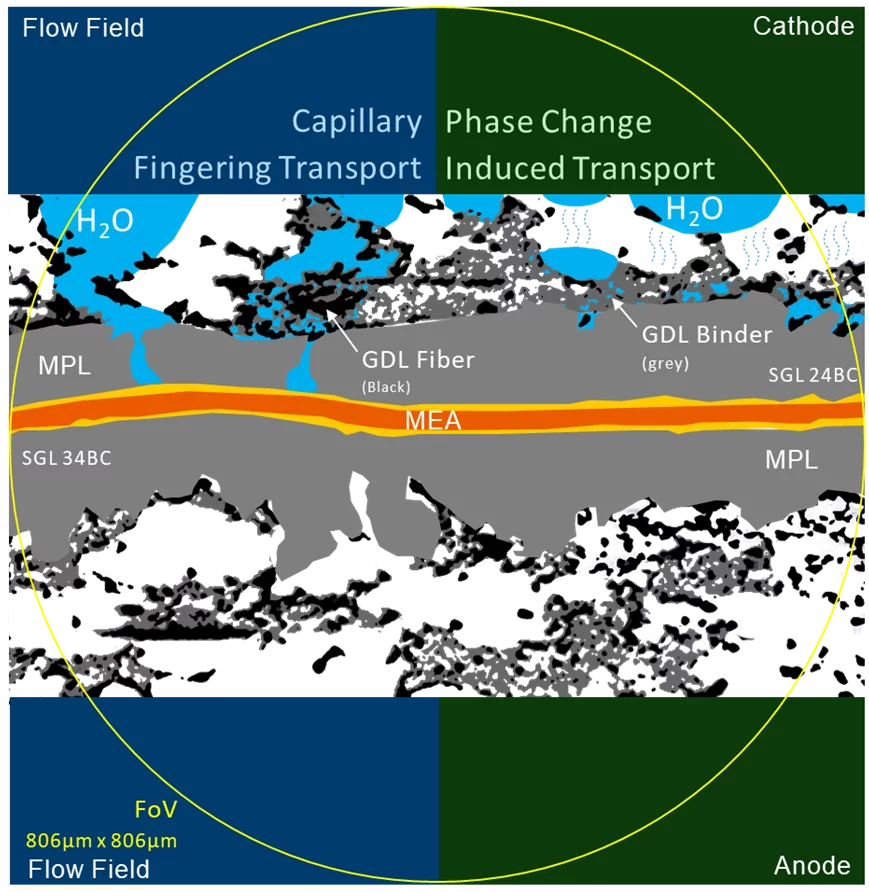Subsecond and submicron operando X-ray tomographic microscopy (XTM) was applied to reveal the water dynamics inside the gas diffusion layer (GDL) of polymer electrolyte fuel cells (PEFC). Utilizing the instrumental advancements in operando XTM of PEFCs the contribution of capillary-fingering and phase-change-induced flow on water transport in GDLs was quantified, for the first time during fuel cell startup at different operation temperatures.
The product water of polymer electrolyte fuel cells (PEFCs) has to pervade the gas diffusion layer (GDL) and can lead to shortages of educt gas diffusion pathways to the catalyst layer hence to significant performance losses. Recent efforts enabled subsecond and submicron operando X-ray tomographic microscopy (XTM) over a wide range of cell operating temperatures. The short XTM scan times allowed to quantify the water transport inside the cathode GDL at elevated operating temperatures during a current ramp-up process. Two major water transport mechanisms for water emerging from the catalyst layer (CL) towards the flow fields (FF) are commonly considered in the literature, namely capillary-fingering of liquid water through the pores of the gas diffusion layer, and gas phase transport of water vapor. The water distribution during a current ramp up process was investigated and analyzed for several locations in the GDL, including MPL cracks, GDL and GDL binder pores. At both temperatures of 40 °C and 80 °C, capillary-fingering as well as phase-change-induced water transport was observed, though with different contributions. At 40 °C the through-plane water distribution was “downhill-like” from the MPL to the flow field similar to observations in ex situ liquid injection experiments. The water distribution was initially driven by bottom-connected water clusters located at the GDL-MPL interface, while already after 50 s fully-connected clusters that span from the GDL-MPL interface to the GDL-flow field were dominating. At a typical automotive PEFC operating temperature of about 80 °C, at the initial low saturation level, phase-change-induced flow efficiently works for water removal without impeding reactant gas pathways. The through-plane water distribution was more “valley-like” with the saturation increasing mainly at the GDL-MPL and GDL-flow field interface in the first 25 s. Top-connected water clusters located at the GDL-FF interface dominate the water distribution in the first 30 s. These clusters are initially small and disconnected, but grow and merge over time. As soon as the top-connected phase-change-induced water clusters merge with the capillary-fingering driven bottom-connected clusters, fully-connected water clusters dominate the water distribution after only about 40 s. The possibility of investigating water dynamic phenomena with both high spatial and temporal resolution utilizing synchrotron XTM facilities enables a broad field of future studies of liquid water dynamics in porous transport layers in PEFCs.
Contact
Dr. Jens Eller
Scientist, Fuel Cell Systems and Diagnostics Group
Paul Scherrer Institut
5232 Villigen PSI
Switzerland
Telephone: +41 56 310 23 96
E-mail: jens.eller@psi.ch
Original Publication
Temperature Dependent Water Transport Mechanism in Gas Diffusion Layers Revealed by subsecond Operando X-ray Tomographic Microscopy
Hong Xu, Shinya Nagashima, Hai P. Nguyen, Keisuke Kishita, Federica Marone, Felix N. Büchi, and Jens Eller
Journal of Power Sources, 470, 229492 (2021)
DOI: 10.1016/j.jpowsour.2021.229492
Acknowledgement to Funding Agency
Swiss National Science Foundation (grant No. 200021 166064).

